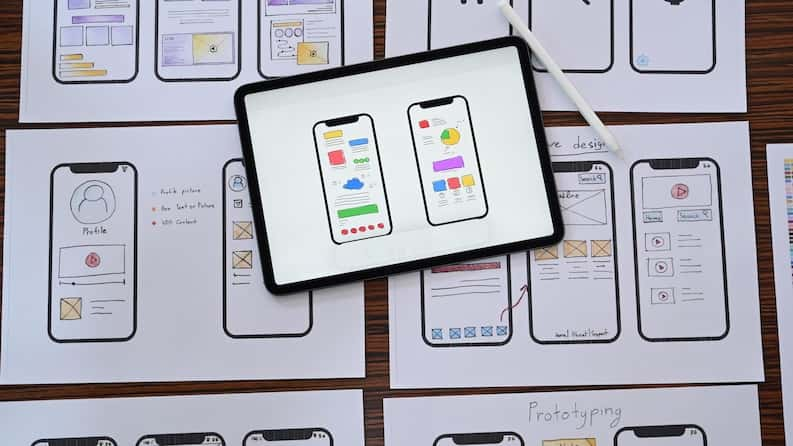88% of users avoid visiting your website a second time if they had a bad experience. This indicates you need to hire front-end developers highly skilled in building websites and web applications.
Finding a front-end developer isn’t as easy as it looks – especially if you lack expertise in hiring one. But you don’t have to fret since this article will reveal the detailed process of hiring and onboarding a candidate.
Without further ado, let’s get started.
Why Should You Hire Front-End Developers For Your Business?

Front-end developers contribute to the visual appeal, functionality, and user satisfaction of your website or web application. They are a valuable asset to your team. Here are the five primary reasons to hire front-end developers.
Enhanced User Experience

Front-end developers create visually appealing and user-friendly interfaces. They ensure your website or application is intuitive, easy to navigate, and optimized for a seamless user experience. A positive user experience leads to higher customer satisfaction and increased engagement. This helps you boost your business’s reputation and conversion rates.
Consistent Branding

They maintain consistent branding across your digital platforms through visual elements like colors, typography, and logo placement. This consistency reinforces brand recognition and helps establish a strong, professional image in the minds of your customers.
Faster Loading and Performance

Performance is critical to user satisfaction and search engine rankings. Optimizing the code, images, and other elements, front end developer ensures fast loading times and smooth interactions. So, you can reduce bounce rates, keep visitors engaged, and improve your chances of retaining customers.
Responsive and Cross-Device Compatibility

Specializing in creating designs, they make the design adapt seamlessly to various screen sizes and devices. This responsiveness ensures that your website or application functions well on desktops, tablets, smartphones, and other devices. Ultimately, it caters to a wider audience and improves accessibility.
Innovation and UI/UX Trends

By hiring skilled front-end developers, you gain access to their insights and innovative ideas. This enables you to implement fresh design elements and stay ahead of the competition. Their ability to integrate cutting-edge features and interactions gives your business a competitive edge.
A Comprehensive Guide to Hire Front-End Developers and Onboard Them
Defining Your Front-End Development Needs

Defining your front-end development needs before hiring a front-end developer helps you find the right candidate who aligns with your project requirements. Here’s a detailed way to do it:
Clarify Project Goals and Scope
- Understand the purpose of your project and what you aim for from the front-end developer for hire.
- Define the scope of your project, including its features, functionalities, and deliverables expected from the front-end developer.
Identify Technologies and Platforms
- Determine the technologies and platforms your project will use. For example, will you use specific frameworks (e.g., React, Angular, Vue.js), libraries, or content management systems?
- Consider whether your project will be web-based, mobile-responsive, or a combination of both.
User Experience and Design Requirements
- Outline your user experience (UX) goals. What kind of interactions, animations, and user flows are you aiming for?
- Specify the design requirements, including branding guidelines, color schemes, typography preferences, and any existing design assets.
Performance and Optimization
- Decide on the performance benchmarks for your project. What loading times, page speed, and responsiveness targets do you want to achieve?
- Determine if there are any specific optimization requirements, such as image compression, lazy loading, or code minification.
Mobile-First and Responsive Design
- Determine if your project requires a mobile-first approach, especially if a significant portion of your audience uses mobile devices.
- Specify the level of responsiveness required for different screen sizes and devices.
Browser Compatibility
- Identify the browsers and devices you need to support. This will influence the testing and compatibility efforts of the front-end developer for hire.
Budget and Timeline
- Determine your budget for hiring a front-end developer. This will help you find candidates whose compensation expectations align with your resources.
- Set realistic timelines for the project and communicate deadlines to potential candidates.
Document Your Requirements
- Compile all your findings into a comprehensive document or job description. This document will serve as a clear reference for communicating with potential candidates.
Creating a Job Description

A well-crafted job description attracts qualified candidates and sets clear expectations for the role. It’s a crucial step in finding and hiring a front-end developer for your team. Here’s a step-by-step way to create an effective job description:
Job Title
- Start with a clear and concise job title that accurately reflects the role, such as “Front-End Developer” or “UI/UX Developer.”
Introduction
- Provide a brief overview of your company and its mission to give candidates context about your organization.
Job Summary
- Write a concise paragraph outlining the primary responsibilities and objectives of hiring a front-end developer. This is your opportunity to grab candidates’ attention and give them a sense of what the role entails.
Key Responsibilities
List the main tasks and responsibilities the front-end developer for hire will be responsible for. Be specific and prioritize the most important duties. Example responsibilities could include:
- Developing user interfaces for web applications using HTML, CSS, and JavaScript.
- Collaborating with designers to implement responsive designs and interactive features.
- Optimizing web pages for speed and performance.
- Ensuring cross-browser and cross-device compatibility.
- Troubleshooting and debugging front-end issues.
Required Qualifications
Clearly outline the qualifications, skills, and experience you’re looking for to hire front-end developers. This helps candidates self-assess their suitability for the role. Example qualifications might include:
- Proficiency in HTML, CSS, and JavaScript.
- Experience with front-end frameworks such as React or Angular.
- Familiarity with responsive design principles.
- Strong understanding of browser rendering behavior and performance optimization.
- Knowledge of version control systems (e.g., Git).
Benefits and Perks
- Mention the benefits or perks that your company offers. Such as a competitive salary, flexible work arrangements, professional development opportunities, health benefits, or company events.
Application Process
- Clearly outline the steps candidates should take to apply. Include information on how to submit their application, the documents you require (e.g., resume, portfolio), and application deadlines.
Contact Information
- Provide a contact person’s name and email address for any inquiries candidates may have about the position.
Closing Statement
- Conclude the job description with an encouraging note, expressing your interest in receiving applications from qualified candidates.
Formatting and Branding
- Use a clean and professional format that matches your company’s branding. Use bullet points and headings to make the content easily scannable.
Sourcing and Hiring
Sourcing and hiring is a two-way process. Just as you’re evaluating candidates, they’re also evaluating your company. Creating a positive and respectful experience for candidates will help you attract top talent to your front-end development team.
Here’s how to effectively source and hire front-end developers:
Tap into Professional Networks
- Leverage your personal and professional networks to spread the word about the job opening. Your connections might know suitable candidates or can refer you to others who do.
Attend Industry Events
- Attend conferences, workshops, meetups, and online forums related to front-end development. These events are great opportunities to meet potential candidates and learn more about the latest trends in the field.
Utilize Social Media
- Share the job posting on your company’s social media channels. Use relevant hashtags and keywords to increase visibility. You can also join front-end development groups on platforms like LinkedIn or Facebook and share the job opening there.
Conduct Technical Interviews
- Shortlist candidates for technical interviews. These interviews can involve coding challenges, problem-solving tasks, or discussions about their previous projects. This step helps you gauge their technical proficiency and problem-solving abilities.
Pair Programming or Coding Tests
- If possible, consider hiring a front-end developer who participates in pair programming sessions with your existing team members. Alternatively, give them coding tests to complete to evaluate their coding skills and approach.
Check References
- Contact the references the candidate provides to get insights into their work ethic, skills, and collaboration style.
Offer and Negotiation
- Once you’ve identified the right front-end developer for hire, extend a job offer that includes details about compensation, benefits, and other relevant information. Be prepared for negotiations and discussions about terms. Once reach a common agreement, you can hire your developer.
Onboarding and Integration
Onboarding and integrating a front-end developer effectively is essential to ensure their smooth transition into your team and project. Below’s how to onboard and integrate a front-end developer:
Preparation
- Before the developer’s start date, prepare their work environment. Set up their workstation, provide necessary hardware and software, and ensure they have access to all relevant tools and systems.
Welcome and Orientation
- Welcome the front-end developer for hire to the team with a warm introduction. Organize an orientation session to introduce them to your company’s culture, values, and team dynamics. Provide an overview of ongoing projects and the role they’ll play.
Introduction to the Team
- Arrange a team meeting to introduce the new developer to the rest of the team members. Encourage team members to share their roles, responsibilities, and a bit about themselves.
Technical Onboarding
- Provide a detailed walkthrough of the development environment, version control systems, project management tools, and any other tools used by the team.
- Assign a mentor or buddy to guide the developer through technical aspects, answer questions, and provide guidance.
Project Overview
- Provide a comprehensive overview of the project the developer will be working on. Explain the project goals, requirements, user stories, and any design guidelines.
Task Assignments
- Start with smaller tasks or bug fixes to help the developer become familiar with the codebase and development process. Gradually assign more complex tasks as they become more comfortable.
Regular Check-ins
- Schedule regular check-ins with the front-end developer for hire to discuss their progress, address any challenges they’re facing, and offer guidance. Encourage them to ask questions and share their thoughts.
Feedback and Growth
- Regularly provide feedback on their work to help them improve their skills. Discuss their goals and career aspirations, and create a plan for their professional growth within the company.
Open Door Policy
- Maintain an open-door policy where the developer feels comfortable approaching you or their mentor with questions, concerns, or suggestions.
Build Your Dream Team of Developers with VinnCorp
Want to hire front-end developers to build your dream team? VinnCorp has got you covered.
We offer front-end developer hiring services to businesses and enterprises. From meticulous sourcing to three interviews and seamless hiring, we onboard experts with a proven track record. They put their expertise to work and customize your project according to your needs and requirements.
Contact us today to get a quote on front-end developer costs and begin your project.



